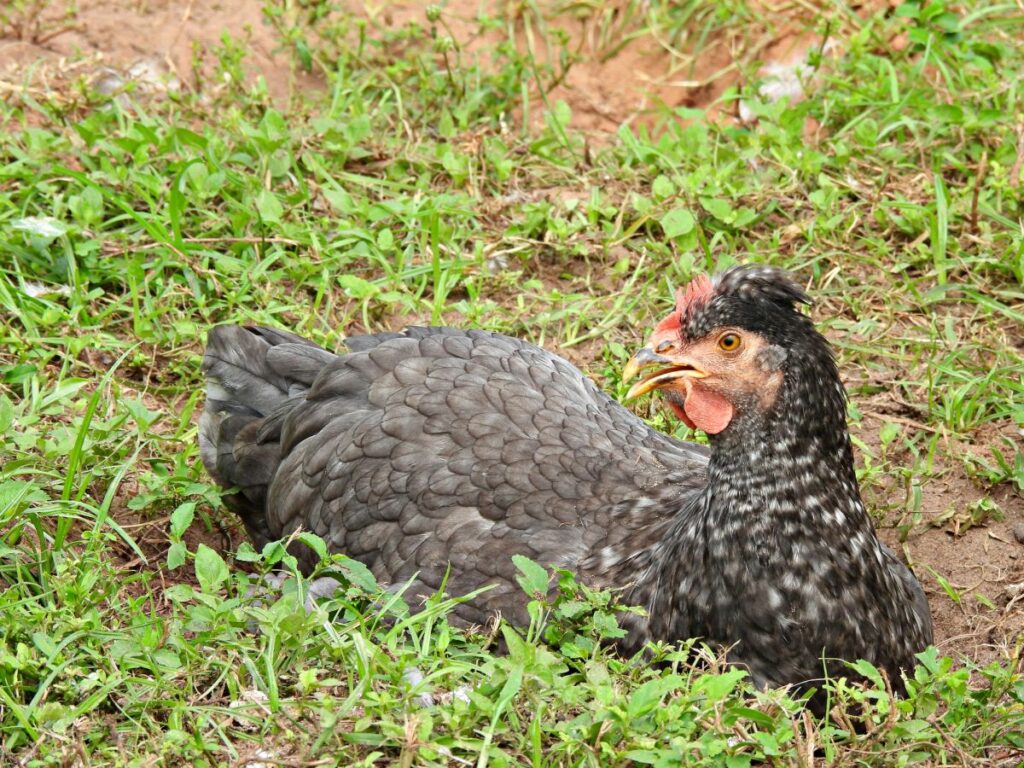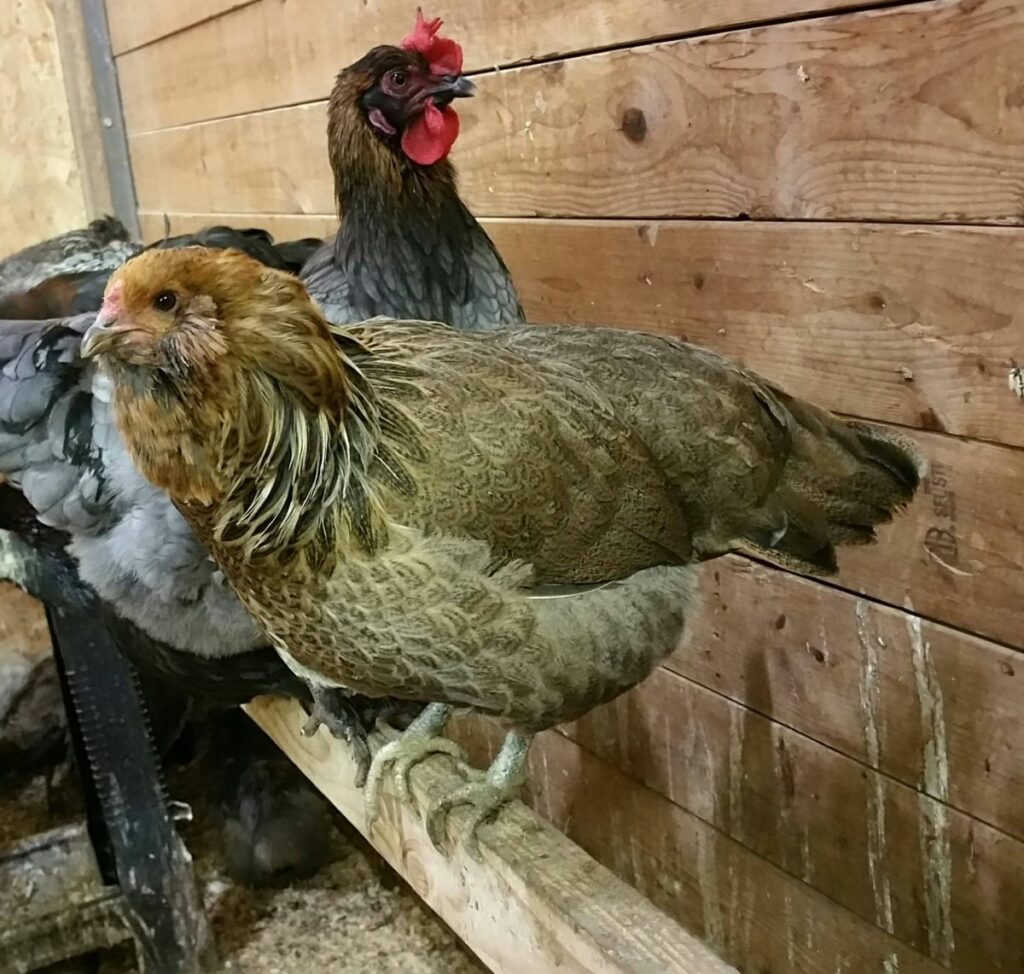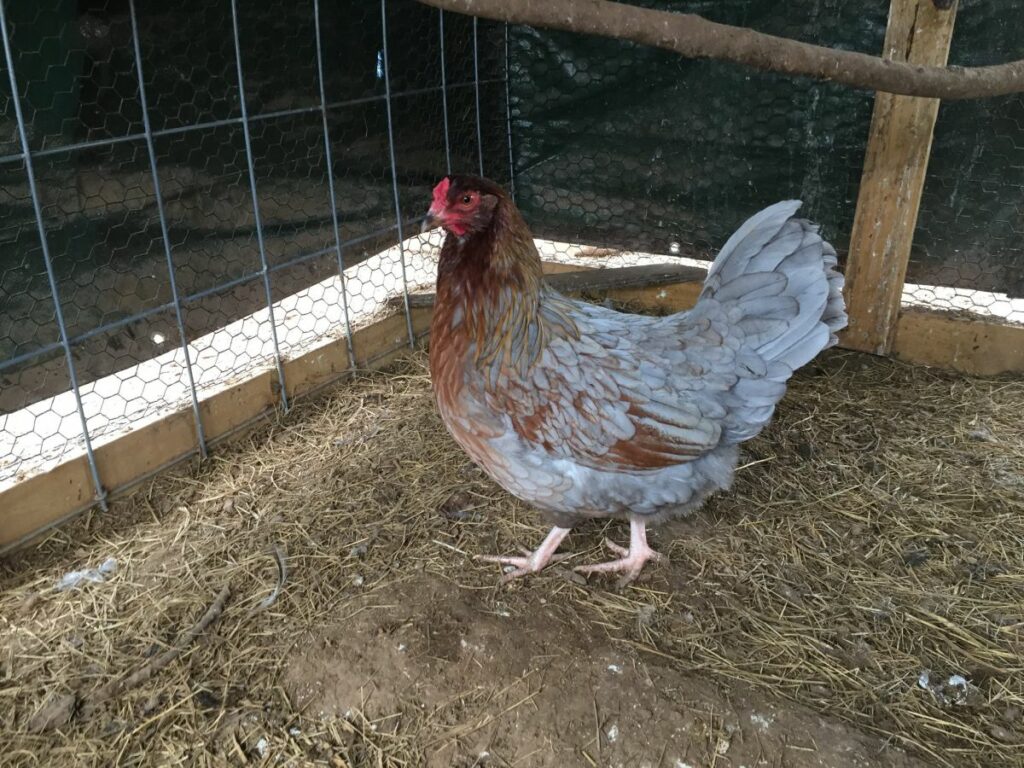An Olive Egger chicken is a popular hybrid breed. They’re beloved for their unique green eggs, which are often olive, hence the breed name.
Hybrid chickens aren’t as predictable as purebred chickens, but they can still make great companions and egg producers. Olive Eggers are a little harder to come by, but they’re worth it for many keepers.
So, is an Oliver Egger right for you? Let’s look at their appearance, personality, and care to help you decide.
Olive Egger Chicken Overview
Before we go into the details of this breed, let’s look at some key traits you can expect.

| Lifespan | Up to 8 years |
| Weight | 6 to 8 pounds |
| Appearance | Gray or black feathers |
| Egg Color | Green |
| Egg Production | 3 to 5 eggs per week, 150 to 200 per year |
| Good for Beginners? | Yes |
| Minimum Coop Size | 4 square feet per bird |
| Price | $4 to $9 per chick |
What is an Olive Egger Chicken Mixed with?
Oliver Eggers aren’t always mixed with the same two breeds. By definition, they can be a combination of any breed that lays blue eggs and any breed that lays brown eggs. The chickens bred usually end up producing green eggs as a result.
Here are some common breeding pairs:
- Ameraucana & Maran
- Araucana & Welsummer
- Legbar & Barnevelder
- Legbar & Maran
- Araucana & Maran
- Ameraucana & Barnevelder
- Ameraucana & Welsummer
- Legbar & Welsummer
- Araucana & Barnevelder
- Whiting True Blue & Welsummer
Since there’s such a wide variety of what breeds these chickens can be mixed with, their appearance, personality, and egg-laying capabilities can vary greatly. This article will cover the general expectation, but anyone buying hybrid chickens need to be aware that they may not end up behaving exactly as expected.
How Do They Create Green Eggs?
Instead of getting a mix of blue and brown eggs, Olive Eggers produce green eggs. That’s because when they lay eggs, they lay one color with a secondary color over top of it.
So, if they produce blue eggs with a brown pigment on top of the blue, the eggs appear green. Thus, green eggs are much more common for hybrids than purebreds.
Olive Egger Chicken Breed History
Breeders began pairing blue egg layers with brown egg layers to create Olive Eggers since 1842. The farmers wanted to find specific traits for the birds in their flocks, which is why cross-breeding was so common at the time.
When farmers began testing a variety of hybrids, the time was known as “hen fever.” Some breed combinations turned out much better than others, so some hybrids gained more popularity over time. Oliver Eggers are an example of a hybrid that ended up being more robust and adaptable than other mixed breed chickens.
However, since they’re a hybrid, they’re not an official breed recognized by the American Poultry Association. Thus, there are no breed standards for them. The only consistent trait for Olive Eggers is that they almost always lay green eggs.

Appearance at Each Life Stage
Olive Eggers are beautiful birds, but they don’t always look exactly the same. In general, here’s how you can expect them to appear from egg to adult.
Olive Egger Chicken Egg Color
Olive Egger chicken eggs are usually olive green. Yet, they can also appear as other shades of green, such as light green or dark green. It’s rare that these medium to large eggs are any other colors, but it’s possible for a few to end up blue or brown.
Olive Egger Chicks
An Olive Egger chick usually has darker feathers than most chicks. Instead of yellow fuzzy feathers, they have a lot of dark brown and black feathers instead. Yet, the color of the parents can influence the color of the chicks.
You can tell the difference between hens and roosters from the moment they hatch. Male chicks will have a white dot on their heads while females won’t.
When the chicks become pullets, they will start to resemble what they’ll look like as adults. Pullets can be a wide range of colors, and they usually look like smaller, less fluffy versions of adult Olive Eggers.
Adult Appearance
Similarly to chicks, the adult appearance of this hybrid will greatly depend on what the parents look like. They usually have darker feathers, such as black, brown, or gray. They could also inherit other unique traits from the parent breeds, such as muffs.
As chicks, you’ll already know which birds are hens and which are roosters. However, as your chicks age, you’ll also notice that the females will grow feathers faster than the males. Then, the males will end up being larger than the females as adults.
Both males and females can have a wide mix of physical characteristics. So, if you’re looking for birds with a specific look, you might want to search for a purebred instead.
Olive Egger Chicken Size
These chickens are about an average weight. Hens are between 6 and 7 pounds with 6.5 being the most common. Then, roosters are between 7 and 8 pounds with 7.5 being typical.
Olive Egger Chicken Temperament
Most Olive Eggers are friendly and docile. Yet, since they can be a combination of several different breeds, their personalities aren’t as predictable as purebred chickens. So, one of your chickens could love being around people while another could be more shy and solitary.
Consider the temperaments of the parents to best determine what the chick will be like. If both parents are friendly and easygoing, there’s a good chance the chicks will be too. If you breed the chickens yourself, this information is easy to find out. Yet, if you go to a breeder, make sure to ask lots of questions before bringing chicks home.

Broodiness
Yes, these hybrids can be broody, but like their temperament, it depends on genetics. Most of the breeds they come from have broody hens, so that’s why many Olive Eggers are broody too.
A broody hen can incubate eggs for you, but she can also be more aggressive if you try to take the eggs from her. So, research dealing with broody hens before caring for these mixed breed chickens.
Noise Levels
These birds makes lots of typical chickens sounds, but they’re not necessarily loud. All chickens have some chattering among the coop, but how loud it is will vary based on the individual bird.
If you live close to your neighbors, it’s probably best to choose a breed that’s more likely to be quiet. With hybrids, you just never know if they’ll disturb your neighbors or not.
Do They Get Along with Other Birds?
Since Olive Eggers are usually docile, they can be kept with other birds. However, it’s best to keep them with other chickens of a similar size and temperament to ensure that none of your birds get picked on. Their parent breeds will usually be the most compatible.
Care Requirements
These hybrids birds have similar care requirements to other chickens, but it’s important to make sure all their needs are met. So, if you’re planning to bring home Olive Eggers chicks, here are some important care requirements.
Feeding
One trait that almost all Olive Eggers share is their love for food. They’re not picky, so they’ll likely eat just about anything you serve to them.
As chicks, start them out with a high protein chick feed to support their growing bodies. Then, once they’re about 16 weeks old, you can transition them to a laying feed for adult hens.
If you want to ensure that your hens lay strong eggs, you can add calcium to your flock’s diet. Oyster shells are the most common calcium supplements for hens, and they should be served separately from their feed.
To mix up their diet a bit, you can give your birds treats once in a while. Fresh produce, such as fruit and vegetables, and excellent treats for chickens.
When serving food, it’s also a good idea to ensure that your flock has fresh water. The water should be replaced at least daily and refilled whenever it’s low to make sure your birds don’t get too thirsty.

Enclosure
These birds are about average sized, so they don’t need too much space. About 4 square feet per bird in the coop is ideal, but feel free to give them more if you’re able. In the run outside the coop, they should have about 10 square feet per bird.
Olive Eggers are curious birds who love to explore and forage, so they need a lot of space outside the coop. They’re great chickens for free-ranging, so if you feel comfortable, give them some time to roam around outside the restrictions of a pen.
Free ranging is a great way for chickens to find extra nutrients on the ground while also removing pests, such as insects and weeds, from your property. It’s also a great way to keep them entertained to reduce the risk of them picking on each other.
As long as food and shelter is provided in their run, they’ll always return to their coop at night.
Your chicken enclosure should also include several nesting boxes for your birds. 12 x 12 x 12 inches is the ideal size for Oliver Eggers, which is the standard nesting box size. However, the appearance of these hybrids can greatly vary, so you may need to readjust their nesting box and coop space once you get to know the birds better.
Temperature
Most Olive Eggers do well in a variety of climates. They’re usually cold hardy birds that may lay eggs in the winter.
However, even the healthiest birds need to be protected in extreme heat and cold. In the summer, make sure your birds have plenty of shade, fresh water, and good ventilation in their coop.
In the winter, make sure their coop is cozy, and purchase a coop heater if needed. Check to make sure they have water that’s not frozen to avoid dehydration. They won’t need as much water in the winter as in the summer, but it’s still important.
Common Health Concerns
These birds are not prone to more health concerns than other breeds and hybrids are. Yet, they can still get many common diseases, so it’s a good idea to vaccinate your birds and be aware of the nearest vet.
A common concern for all chickens is lice and mites. These pests can be difficult to notice, but the longer they stay in your chicken enclosure, the more destructive they’ll be. Keeping the coop clean and replacing bedding often is a great way to prevent tiny pests.
If you notice any unusual behaviors or symptoms in your chickens, take them to the vet just to be safe. Not all vets are able to take birds, so it’s a good idea to research your options before something goes wrong. You can also schedule regular checkups to keep your chickens healthy, but it’s not necessary if your birds seem fine.
Olive Egger Chicken Egg Production
Olive Eggers are decent egg layers. They produce between 3 and 5 eggs per week, which ends up being 150 to 200 per year. Sometimes, they’ll even lay eggs in the winter, which is something many breeds are unable to do.
If you want to produce fertile eggs, you’ll need to have a rooster exposed to some hens. Once the rooster is introduced to the hens, the breeding process will happen on its own. Your hens will start producing eggs that will turn into chicks, so make sure you’re prepared to raise baby chickens.
Whenever you don’t want fertile eggs anymore, you can simply separate the rooster from the hens again. Hens don’t need roosters to produce eggs that are edible for humans. They only need roosters to produce chicks.

Frequently Asked Questions
Before you go and buy some Olive Eggers, make sure you have everything sorted out. Here are a few questions new chicken keepers commonly ask.
Olive Eggers and Easter Eggers are both unique hybrids created to lay colorful eggs. However, Olive Eggers are a special kind of Easter Egger that only lays green eggs while Easter Eggers often lay several different egg colors.
No, it’s possible for Olive Eggers to lay some blue or brown eggs. However, shades of green are much more common. If either of the parent breeds aren’t commonly used for breeding Olive Eggers, that could be why the eggs aren’t always green.
Most Oliver Eggers start laying eggs as early as five months old. Their eggs will be smaller than normal for a while, but they should still have a green hue.
Is an Olive Eggers Chicken Right for You?
Olive Eggers can be great chickens for beginners, especially if you love the green eggs they lay. Yet, if you’re looking for a predictable chicken breed, these birds might not be for you. Olive Eggers have a wide variety of traits and appearances since they’re hybrids. So, keep that in mind when deciding if they’re a good fit for you.
